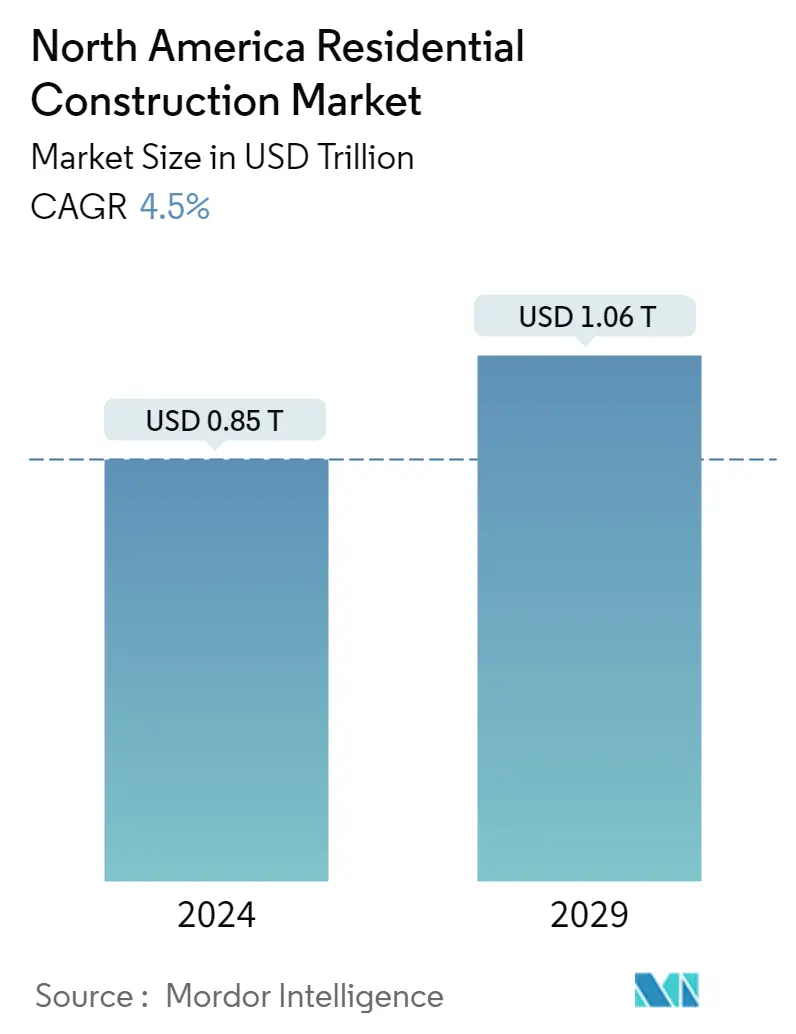Market Size of North America Residential Construction Industry

| Study Period | 2019 - 2029 |
| Base Year For Estimation | 2023 |
| Market Size (2024) | USD 0.85 Trillion |
| Market Size (2029) | USD 1.06 Trillion |
| CAGR (2024 - 2029) | 4.50 % |
| Market Concentration | Medium |
Major Players
*Disclaimer: Major Players sorted in no particular order |
North America Residential Construction Market Analysis
The North America Residential Construction Market size is estimated at USD 0.85 trillion in 2024, and is expected to reach USD 1.06 trillion by 2029, growing at a CAGR of 4.5% during the forecast period (2024-2029).
- Prior to the epidemic, there was already pent-up demand. It was false to say that millennials preferred renting over owning homes. Simply put, millennials lack the resources to own real estate. Some were affected by the Great Recession upon starting their careers; therefore, they did not have the savings of previous generations. Mortgages became less accessible as a result since banks were subject to tougher regulations and had to agree to lower down payments of at least 15-20%. Millennials were finally given the opportunity to buy homes, which boosted the already competitive market. Lockdown forced people to save, government stimulus programs improved their purchasing power, and steeply rising asset values The expectation of more remote employment and different COVID-19 constraints also contributed to significant migrant movements, which further fueled the purchasing frenzy. Strong investment in United States residential will drive industry spending through 2022.
- Cheap home supplies and historically low borrowing rates have boosted residential investment. In 2021, growth intensified as a result of increased home construction activity brought on by pent-up demand and improved vaccination rates among the populace. The demand for housing has also been supported by improvements in the labor economy. Despite this, the Federal Reserve has been forced to hike interest rates in 2022 due to growing inflation and worries of a recession. The time is now to update long-standing housing and urban planning rules and rebalance the supply and demand imbalance. The price of delay might be a severe social catastrophe brought on by a big, intergenerational group of people's discontent with their living circumstances, which would disproportionately affect younger generations.
In November 2022, Canada's investments in building construction dropped 1.4% to USD 20.4 billion. Most of the drop (5.6%) came from Alberta. While the non-residential sector in Canada grew 0.2% to USD 5.5 billion, the residential sector fell 2.0% to USD 14.9 billion.
North America Residential Construction Industry Segmentation
The most important parts of the study report on the North American residential construction market are its analysis of the competition and information about consumers.In-depth looks at market trends, demand projections, and micro- and macroeconomic factors are also part of the research on the North American residential building market.The report also talks about the factors in the market that affect and limit the residential building business.This in-depth business intelligence study is built on qualitative and quantitative market measures. This report also offers readers industry insights and a thorough examination of market categories at potential micro levels. Builders and suppliers for the North American residential building sector are among the companies highlighted in the research.
The North American residential construction market is segmented by property type (single family and multi-family), construction type (new construction and renovation), and region (United States, Canada, and Mexico). The report offers size and forecasts for the North American residential construction market in terms of value (USD billion) for all the above segments. The impact of the COVID-19 pandemic is also covered in the report.
| By Property Type | |
| Single Family | |
| Multi-family |
| By Construction Type | |
| New Construction | |
| Renovation |
| By Region | |
| United States | |
| Canada | |
| Mexico |
North America Residential Construction Market Size Summary
The North America residential construction market is poised for growth, driven by a combination of factors including pent-up demand, government stimulus, and evolving work-from-home trends. The market is characterized by a competitive landscape with numerous players, such as Lennar Corporation, D.R. Horton, and PulteGroup, contributing to its fragmentation. The demand for housing has been bolstered by historically low borrowing rates and improvements in the labor economy, although rising interest rates and inflationary pressures pose challenges. The market's expansion is further supported by increased investments in prefabricated housing and major construction projects, which are expected to enhance competition and drive growth during the forecast period.
In Canada, the residential construction sector has faced some setbacks, with a decline in investments noted in recent years, particularly in Alberta. Conversely, Mexico's housing market is experiencing a growing demand for new homes, necessitating significant investment to meet future needs. The real estate market in regions like Los Cabos has seen unprecedented activity, with substantial increases in home sales and prices. However, rising mortgage rates in Canada and the United States, driven by aggressive rate hikes from central banks, are impacting affordability and could influence market dynamics. Despite these challenges, the North American residential construction market remains optimistic about future growth prospects, supported by ongoing demand and strategic investments.
North America Residential Construction Market Size - Table of Contents
-
1. MARKET INSIGHTS
-
1.1 Current Economic and Residential Construction Market Scenario
-
1.2 Technological Innovations in the Residential Construction Sector
-
1.3 Impact of Government Regulations and Initiatives on the Industry
-
1.4 Industry Value Chain Analysis
-
1.5 Comparison of Construction Cost Metrics of North American Countries (Analyst View)
-
1.6 Impact of COVID-19 on the Market
-
-
2. MARKET SEGMENTATION
-
2.1 By Property Type
-
2.1.1 Single Family
-
2.1.2 Multi-family
-
-
2.2 By Construction Type
-
2.2.1 New Construction
-
2.2.2 Renovation
-
-
2.3 By Region
-
2.3.1 United States
-
2.3.2 Canada
-
2.3.3 Mexico
-
-
North America Residential Construction Market Size FAQs
How big is the North America Residential Construction Market?
The North America Residential Construction Market size is expected to reach USD 0.85 trillion in 2024 and grow at a CAGR of 4.5% to reach USD 1.06 trillion by 2029.
What is the current North America Residential Construction Market size?
In 2024, the North America Residential Construction Market size is expected to reach USD 0.85 trillion.

